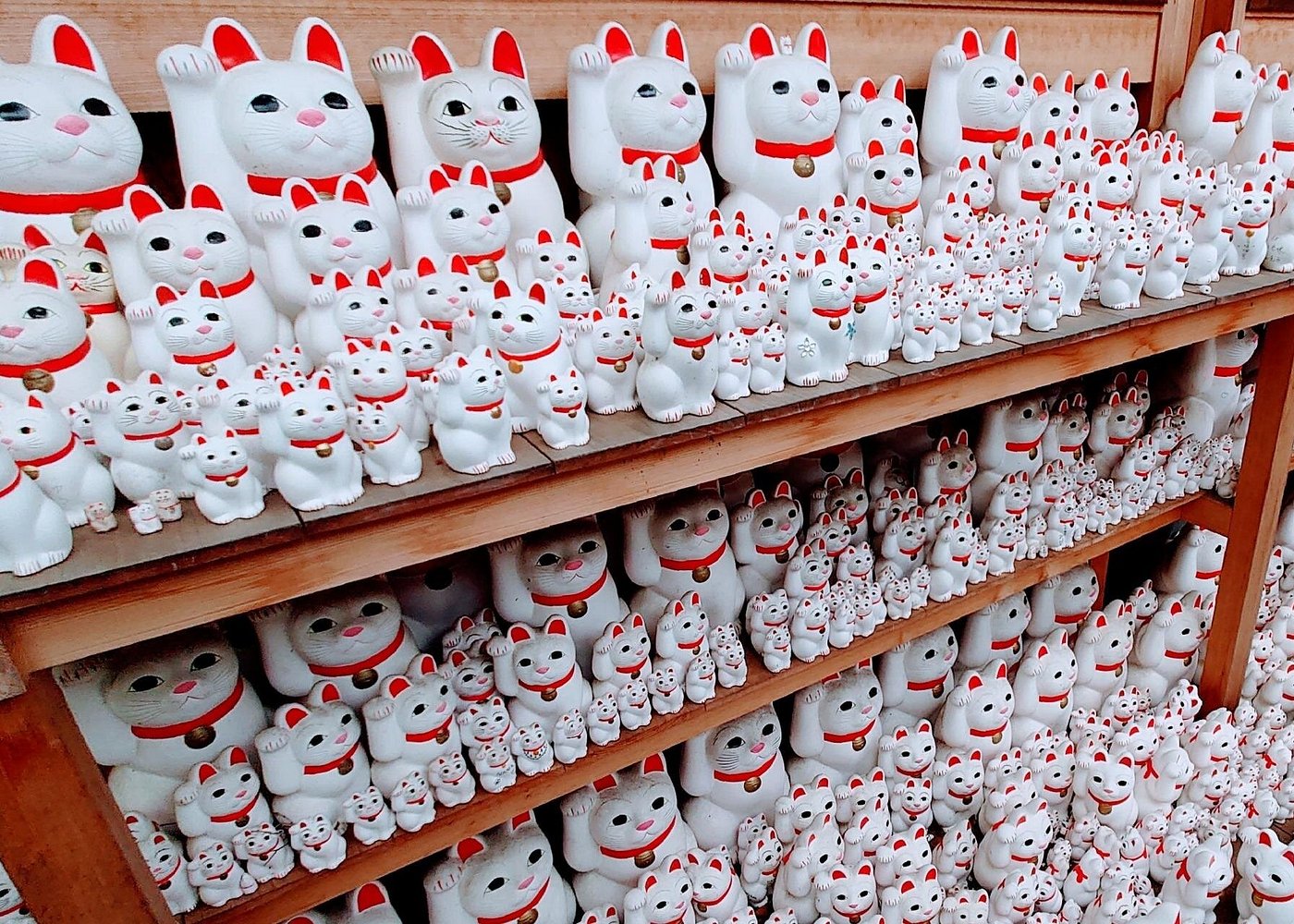
When you check out webs introducing Tokyo, you probably have seen photos filled with cat figurines, right? That place is called Gotokuji (Gotoku Temple), supposedly a spot where cats, whether attracting money or guests, reside. Personally, I just chase cats if I see them.
From there, a short walk takes you to a shrine dedicated to Yoshida Shoin, famous for educating prodigious talents who shaped modern Japan.
A. Start Walking Gokokuji Station, Beckoning Cat:
Start from Gotokuji Station (marked as A on the map) about 20 minutes form Shinjuku on the Odakyu Odawara Line. Gotokuji (Gotoku Temple), famous for Maneki-Neko (Beckoning Cat), is tucked away in the cozy residential area of Setagaya. Once you’re there, why not take a leisurely walk to Shoin Shrine? It honors Yoshida Shoin, the man hosting Shoka Sonjuku , a private school that churned out talents crucial in shaping modern Japan.

B-1. Overview of Gotokuji:
Gotokuji (Gotoku Temple) (marked as B on the map) is a serene Soto Zen temple surrounded by lush greenery on a spacious grounds. The temple grounds are adorned with a variety of plants such as plum, cherry, peony, azalea, and vibrant autumn leaves, offering a delightful change of scenery with each season. At first, it is recommended to take a leisurely stroll through the grounds to fully appreciate the ever-changing beauty of Gotokuji throughout the year.
B-2. Origin of Maneki-Neko (Beckoning Cats):
One day, a lord returning from falconry passed by this area. He was beckoned by a cat near the temple gate and decided to make a stop. While spending time at the temple, suddenly thunder roared, and heavy rain began. The lord, not only avoiding the thunderstorm but also enjoying a pleasant conversation with the Zen Monk, was deeply moved. It is said that this fortunate encounter led the lord to support the temple and make it his family temple, according to a widely circulated auspicious tale.


B-3. Photo-Worthy; Flock of Beckoning Cats?:
Maneki-Neko (Rising Paw Cat Figure) lifting its right paw is said to bring good fortune, while one with its left paw up is thought to invite people (or customers). Some cats have both paws up, but many people find that a bit too much – it’s like saying ‘give up and surrender’ to life’s charms!
In contrast to many other Maneki-Neko that hold a Koban (Gold Coin), Gotokuji’s Maneki-Neko, true to its origins from a Samurai’s family temple, doesn’t carry the Koban and rises only its right paw, symbolizing the invitation of good fortune. Officially, the Maneki-Neko is seen as providing opportunities, but whether the actual result (in this case, the Koban) depends on the individual’s efforts.
It’s worth noting that various-sized Maneki-Neko are available for purchase at this temple as a luck charm, although they may not always be in stock.
PR Discover Cute Japan
Gotokuji Temple and Shimokitazawa Day Tour presented by Viator;
C-1. Ideal Educator of Yoshida Shoin:
If you walk for about 15 minutes from Gotokuji, you’ll reach Shoin Shrine (marked as C on the map). The shrine was erected by Yoshida Shoin’s disciples to honor and worship him at the place where he was buried.
Yoshida Shoin (1830-1859) was a real historical figure who lived in the late Edo period. Renowned for hosting the Shoka Sonjuku, he played a significant role in nurturing numerous talents that contributed to transforming Japan from the feudal Edo era to the beginning of the modern state; the Meiji era. Without the individuals he nurtured, the present-day landscape of Japan would likely be significantly different.


C-2. Fired-up individual, Yoshida Shoin:
Yoshida Shoin’s own life is also intriguing.
He faced capital punishment, being executed by beheading at the age of 30. This because of a consequence of his own confession to attempt the assassination of a high government official. Even facing capital punishment, he couldn’t bring himself to tell a lie as long as he believed he was doing the right thing.
He held the belief of putting the Emperor at the center and using force to repel foreign interference. However, he also acknowledged the cultural and technological gap between foreign countries and Japan, understanding the need to learn from them. Despite the government’s prohibition, he even made direct contact with foreign ships and attempted to travel abroad. As a result, he found himself in prison for an extended period. With the advent of the Meiji era, Japan swiftly embraced learning from foreign nations to establish a modern state, abandoning the idea of using force to resist foreign interference. It’s intriguing to wonder how Yoshida Shoin would have perceived the policy shift of the Meiji government.
C-3. Small but Great School Shoka Sonjuku:
Within the shrine, there is a replica of the Shoka Sonjuku. It’s quite moving to think that from such a small building, talents emerged that played a crucial role in advancing Japan into a modern nation. If you ever wish to see the original building, it still stands at Shoin Shrine in Yamaguchi Prefecture , located at the southern tip of Honshu (Main Island).

After visiting Shoin Shine, the nearest station is Shoin Jinja-mae Station (marked as D on the map) on the Tokyu Setagaya Line. When you take the train bound for Shimotakaido and get off at Yamashita Station, you can return to the starting point, Goutokuji Station (marked as A on the map) on the Odakyu Odawara Line. Taking the same Odakyu Odawara Line back to Shinjuku is the simplest route, just like when you arrived.

The Cat Temple is interesting and all, but I prefer Shoin Shrine. However, in an ironic twist of history, among the talents nurtured by Shoin, some outstanding individuals fell during the battles to overthrow the Tokugawa Edo Regime around 200 years ago, leaving behind, well, reasonably capable folks. Well, I guess Japan’s modern era was built by ordinary people working diligently.


